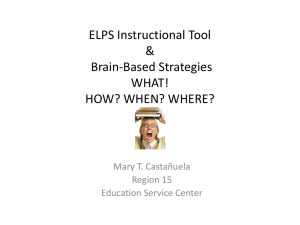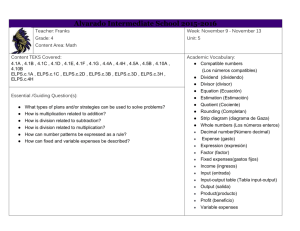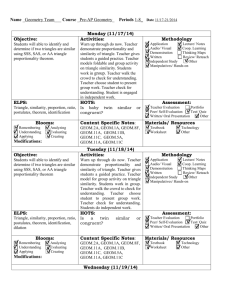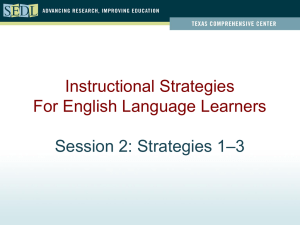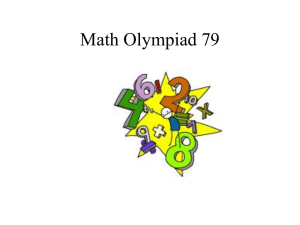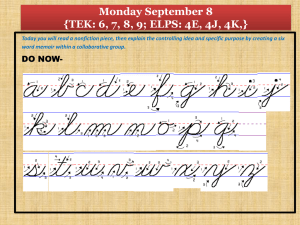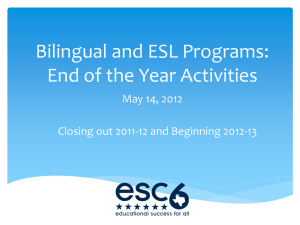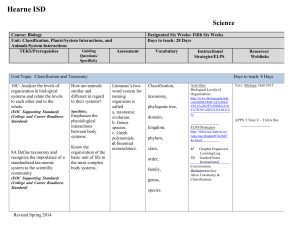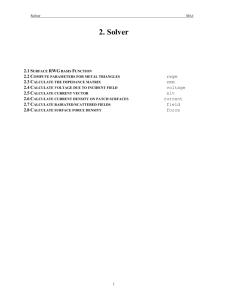Weekly Lesson Plan
advertisement
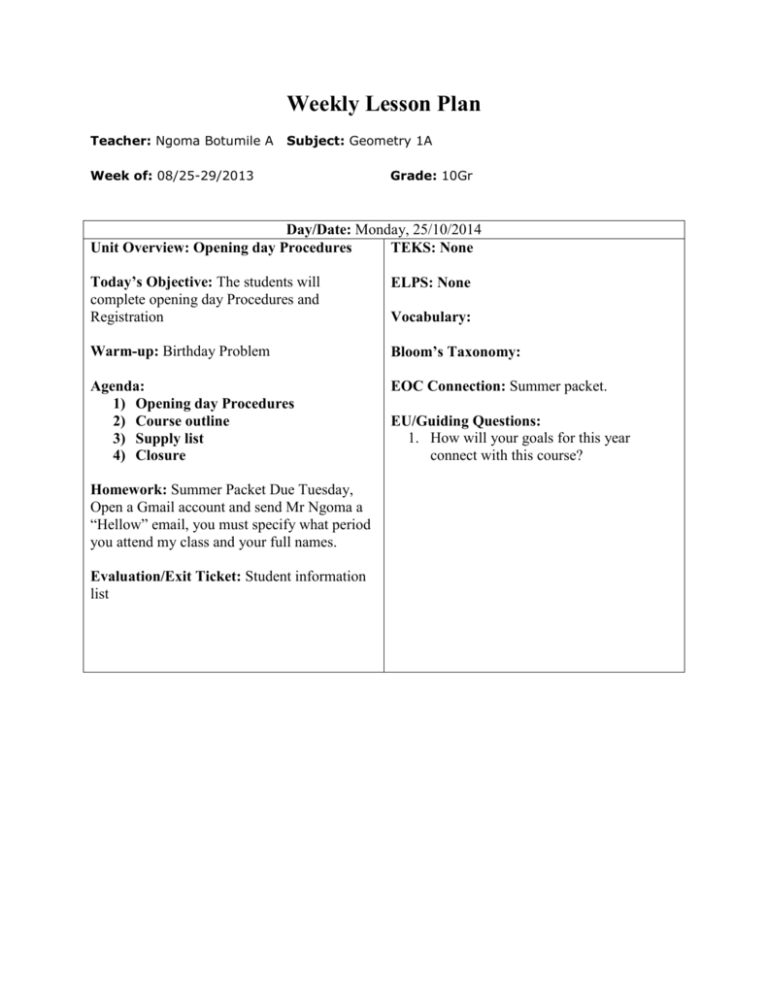
Weekly Lesson Plan Teacher: Ngoma Botumile A Subject: Geometry 1A Week of: 08/25-29/2013 Grade: 10Gr Day/Date: Monday, 25/10/2014 Unit Overview: Opening day Procedures TEKS: None Today’s Objective: The students will complete opening day Procedures and Registration ELPS: None Warm-up: Birthday Problem Bloom’s Taxonomy: Agenda: 1) Opening day Procedures 2) Course outline 3) Supply list 4) Closure EOC Connection: Summer packet. Homework: Summer Packet Due Tuesday, Open a Gmail account and send Mr Ngoma a “Hellow” email, you must specify what period you attend my class and your full names. Evaluation/Exit Ticket: Student information list Vocabulary: EU/Guiding Questions: 1. How will your goals for this year connect with this course? Day/Date: Tuesday, 08/26/2014 Unit 1 Overview: Geometry Foundations TEKS: with Algebra Connections – Students study geometry topics in connections with algebraic expressions and equations Today’s Objective: Students will define and identify geometric vocabulary using a 3-D model of a square prism and Frayer model template. Warm-up: Using your cell phone, iPad, iPod, etc Google the word geometry and write a short story of what you expect to learn in this course (write in you notebook) Agenda: 1. Warm-up 2. Genius Test 3. 3-D model (Prism) building blocks 4. Frayer Model on paper Video 5. Frayer Model for Skew lines 6. Deductive Vs Inductive reasoning 7. Exit Ticket (Using TI-Nspire as calculator) 5 min Exploration Homework: Accept the dropbox invitation and open the document that is in the folder and follow the instructions from the document. Evaluation/Exit Ticket: Complete the List of computations using the TI-Nspire as a calculator to explore the functions of the TINspire. GEOM.1A Develop an awareness of the structure of a mathematical system, including the need for definitions and the use of logical reasoning to verify statements. Ⓢ GEOM.3E Use deductive reasoning to prove a statement. Ⓢ GEOM.7A Employ one- and two-dimensional coordinate systems to represent points, lines, rays, line segments, and figures. Ⓡ GEOM.7C Derive and use formulas involving horizontal, vertical, and oblique distances, slope, and midpoint and use in context to applications of distance and midpoint formulas. ELPS: ELPS C.1e Internalize new basic and academic language by using and reusing it in meaningful ways in speaking and writing activities that build concept and language attainment. ELPS C.3e Share information in cooperative learning interactions. ELPS C.5g Narrate, describe, and explain with increasing specificity and detail to fulfill content area writing needs as more English is acquired. Vocabulary: 3-D Point Line Line segment Plane Skew lines Bloom’s Taxonomy: Evaluate and Apply EOC Connection: See 1A and 3E Mini assessments Essential Understanding/Guiding Questions: 1. How are points, lines, planes, and segments similar or different? Day/Date: Wednesday, 08/27/2014 Unit 1 Overview: Geometry Foundations TEKS: with Algebra Connections – Students study geometry topics in connections with algebraic expressions and equations Today’s Objective: Students will explore lines, rays, points, segments, and figures in one -, two-, and Three- dimensional coordinate system, and triangles on coordinate plane( C.P.). Warm-up: Using your cell phone, iPad, iPod, etc Google the word geometry and write a short story of what you expect to learn in this course (write in you notebook) Agenda: 1. Warm-up 2. 2-D Cartesian plane review on graph paper 3. Explore lines, rays, points on C.P. 4. Draw triangles on C.P. 5. Identify Horizontal, Vertical, and oblique segment. 6. Remind to prove the triangle name on Friday, after distance formula study 7. Construct a 3-D on x-y-z plane. Identify the vertices. (Use grid paper) 8. Exit Ticket (Using TI-Nspire as calculator) 5 min Exploration Homework: Using Pythagorean theorem as learned in 8th grade, Solve for the hypotenuse for each case: #1) Legs are 3 and 4, # 2)Legs are 4x and 7x, #3) Legs are (2x +1) and (2x – 3). Evaluation/Exit Ticket: Complete the List of computations using the TI-Nspire as a calculator to explore the functions of the TINspire. Basic Math: 1) Identify the slope of 2y – 3x = 6 GEOM.1A Develop an awareness of the structure of a mathematical system, including the need for definitions and the use of logical reasoning to verify statements. Ⓢ GEOM.3E Use deductive reasoning to prove a statement. Ⓢ GEOM.7A Employ one- and two-dimensional coordinate systems to represent points, lines, rays, line segments, and figures. Ⓡ GEOM.7C Derive and use formulas involving horizontal, vertical, and oblique distances, slope, and midpoint and use in context to applications of distance and midpoint formulas. ELPS: ELPS C.1e Internalize new basic and academic language by using and reusing it in meaningful ways in speaking and writing activities that build concept and language attainment. ELPS C.3e Share information in cooperative learning interactions. ELPS C.5g Narrate, describe, and explain with increasing specificity and detail to fulfill content area writing needs as more English is acquired. Vocabulary: 3-D (x, y, z) Collinear and Coplanar Cartesian Plane Horizontal, Vertical and Oblique segments Bloom’s Taxonomy: Analysis and Application EOC Connection: See Geom.7A from Mini assessments handout packet Essential Understanding/Guiding Questions: 1. How are linear equation connected to lines and line segments? 2. How does slopes of a line relate to Horizontal, Vertical, and Oblique segments Day/Date: Thursday, 08/28/2014 ( 1.5 days Lesson) Unit 1 Overview: Geometry Foundations TEKS: with Algebra Connections – Students study geometry topics in connections with algebraic expressions and equations Today’s Objective: Students will Derive the midpoint and distance formula for oblique segments using the Pythagorean theorem Warm-up: Using grid paper determine the length of the following segments #1) A(2,4) and B(2, -5), #2)D(-3, 4) and E(7, 4) Agenda: 1. Warm-up: Review warm up problem 2. Use warm-up problems to breakdown the midpoint formula as learned in alg 1. 3. Review H/W Pr. #2 and #3 4. Derive the distance equation: use two columns:(Numeric Column and Variable Column) 5. Discuss the importance of Derivations in geometry. 6. Discuss the difference between (X1 – X2) Vs (X2 – X1) for slope and distance formula 7. (Using TI-Nspire as handheld device) 5 min Exploration 8. Exit Ticket: See below Homework: 1)Solve Problems from Geom 7C packet, relating to distance formula. 2) Summer packet is due Friday. Evaluation/Exit Ticket: Write a summary after discussing and comparing notes with your group member, about what you have learned in this class room the past four days. Basic Math: 2) Develop an equation of line that is perpendicular to 2y – 3x = 6 and shares the same y-intercept. GEOM.1A Develop an awareness of the structure of a mathematical system, including the need for definitions and the use of logical reasoning to verify statements. Ⓢ GEOM.3E Use deductive reasoning to prove a statement. Ⓢ GEOM.7A Employ one- and two-dimensional coordinate systems to represent points, lines, rays, line segments, and figures. Ⓡ GEOM.7C Derive and use formulas involving horizontal, vertical, and oblique distances, slope, and midpoint and use in context to applications of distance and midpoint formulas. ELPS: ELPS C.1e Internalize new basic and academic language by using and reusing it in meaningful ways in speaking and writing activities that build concept and language attainment. ELPS C.3e Share information in cooperative learning interactions. ELPS C.5g Narrate, describe, and explain with increasing specificity and detail to fulfill content area writing needs as more English is acquired. Vocabulary: Bisector Distance formula Square roots Bloom’s Taxonomy: Synthesis EOC Connection: See Geom.7C from Mini assessments handout packet Essential Understanding/Guiding Questions: 1. How are the Pythagorean theorem and the distance formula related to each other? 2. How will you write the distance formula for a 3-D distance. Day/Date: Friday, 08/29/2014 (Continue from Thursday) Unit 1 Overview: Geometry Foundations TEKS: with Algebra Connections – Students study geometry topics in connections with algebraic expressions and equations Today’s Objective: Students will Derive the midpoint and distance formula for oblique segments using the Pythagorean theorem and solve problems relating to distance formula Warm-up: Using grid paper draw a rectangular prism, were the origin is not one of the vertices. Agenda: 1. Warm-up: Review warm up problem 2. Complete Thursday lesson 3. From the warm-up let each group determine the distance from the bottom-front-left vertex to the topback-right vertex using one of their Prism. (3-D application of distance formula) 4. Problem solving including Springboard Problems using ipads 5. Collect Summer packets 6. (Using TI-Nspire as handheld device) 5 min Exploration 7. Exit Ticket: Two problem quiz Homework: 1)Work on TEKS Packets Evaluation/Exit Ticket: Two Problems Basic Math: 3) Develop an equation of line that is perpendicular to 2y – 3x = 6 and shares the same x-intercept. GEOM.1A Develop an awareness of the structure of a mathematical system, including the need for definitions and the use of logical reasoning to verify statements. Ⓢ GEOM.3E Use deductive reasoning to prove a statement. Ⓢ GEOM.7A Employ one- and two-dimensional coordinate systems to represent points, lines, rays, line segments, and figures. Ⓡ GEOM.7C Derive and use formulas involving horizontal, vertical, and oblique distances, slope, and midpoint and use in context to applications of distance and midpoint formulas. ELPS: ELPS C.1e Internalize new basic and academic language by using and reusing it in meaningful ways in speaking and writing activities that build concept and language attainment. ELPS C.3e Share information in cooperative learning interactions. ELPS C.5g Narrate, describe, and explain with increasing specificity and detail to fulfill content area writing needs as more English is acquired. Vocabulary: Distance formula Square roots Bloom’s Taxonomy: Synthesis EOC Connection: See Geom.7C from Mini assessments handout packet Essential Understanding/Guiding Questions: 1. If the distance between two points is 12 and one of the points is (2, -5) find one point that will satisfy these conditions, How many possible points are there?
